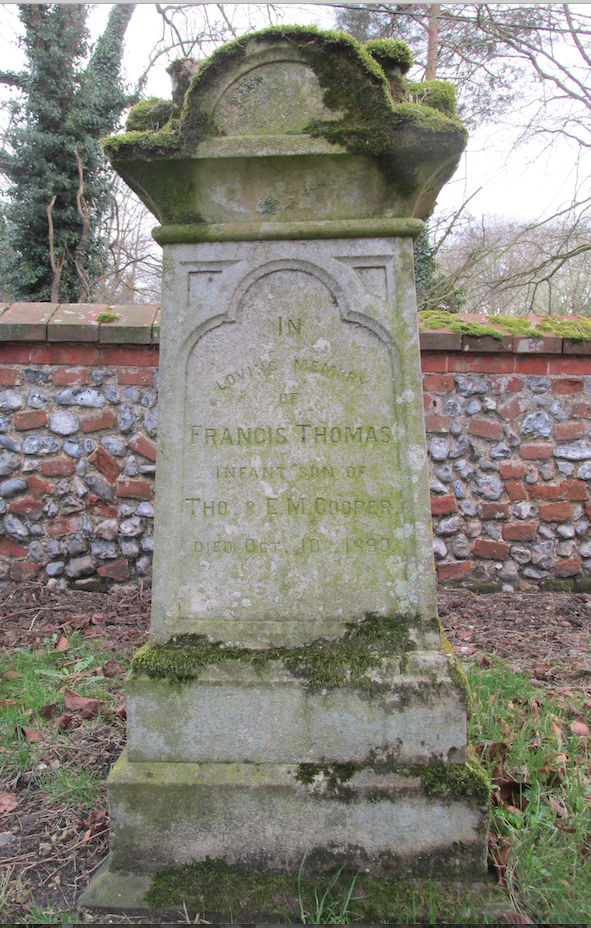Ryburgh Remembers
L./Cpl. Charles Veasey Cooper
4th Btn. Australian Imperial Force

August 1889 - September 19th. 1918
The man who as manager established the reputation of the Ryburgh Farmers’ Foundry in the early 1880’s was Thomas Cooper . Of the nine children born to Thomas Charles Cooper and Elizabeth Maria Mann Veasey, Charles Veasey Cooper was their eldest son, born in August 1889 at The Vines next to the Foundry in Station Road:

Six of their children were baptised at St Andrew's, though due to Cooper's difficult relationship with incumbent Morris Fuller, the baptism of three of the children, among them Charles, was delayed until 1890 after the arrival of Revd. Henry Fowler-Baker:

The youngest of these three, Francis Thomas died aged only 10 days old and his memorial was placed centrally near to the wall between the two churchyard gates:

Although Thomas Cooper continued to run the Foundry in Ryburgh, he moved to King's Lynn in 1894 where he had built a new house near to his newly established King's Lynn Steam Digger Company factory, premises which eventually became the home of his now internationally famous Cooper Roller Bearings.
Charles was educated, first at home and then at King Edward Vll Grammar School, King’s Lynn. By 1904 he had left school to join his father’s Steam Digger Company and by the time he was 19, having gone to Africa with a consignment of exported Diggers, he was trading ivory, spices and coffee in Uganda. Clearly a restless soul, his next port of call was Australia and Gogeldrie Station (sheep) though he seems to have drawn on his steam upbringing as he stated that his occupation was that of engine driver when he enlisted. Apparently it had been his intention to eventually return to the UK via South America and the Andes but these plans were interrupted by the outbreak of the War in Europe.
He enlisted at Whitton N.S.W on the 30th March 1916 and some days later was accepted into the Australian Imperial Force and joined camp at Cootamundra on the 11th. April. At his preliminary medical examination he was passed provisionally fit for active service with the note:
“Has a cleft palate, hard and soft. I do not think he will be an efficient soldier. Give him a trial.”
At this time he was aged 29 yrs. 9 mths., 5‘ 8 “ tall , 12st. 2lbs, fair complexion, blue eyes, light brown hair and C of E. Distinctive marks: 5” long scar on right shoulder.
By September 1916 he was with the 4th Btn. Australian Imperial Force and on his way to Portsmouth U.K.aboard H.M.A.T. Euripedes. He was drafted to France in Feb. 1917 appointed L/Cpl in the field in June and returned to the UK on leave in Jan. 1918. This would have been the last time he saw his family in King’s Lynn. His brothers Gerald and Alan joined up that year. He returned to the front to take part in the Spring Offensive on the Somme and died on September 19th. at the 53 Casualty Clearing Station, two inevitably agonizing days after a gunshot wound to his right hip. The records of the Australian Imperial Force are extrememely comprehensive and accesible online. Charles' service record, from where most of this information has been gleaned, is freely available.
More information about the 4th Battalion can be found here and I quote a short section from those pages:
"In 1918 the battalion returned to the Somme valley and helped to stop the German spring offensive in March and April. The battalion subsequently participated in the Allies' great offensive of that year, launched east of Amiens on 8 August 1918. The advance on this day by British and Empire troops was the greatest success in a single day on the Western Front, one that German General Erich Ludendorff described as "the black day of the German Army in this war".The battalion continued operations until late September 1918."
He had nothing to leave at his death save a £10 Treasury Bond which was bequeathed to a Mary Powell of Gogeldrie Station at Whitton where he was living when he joined up. His personal effects and 2 medals were sent to his father Thomas.

(1978 205.42)
Charles' parents, Thomas and Elizabeth Cooper with Alan, Gerald (younger brothers) and one of his three sisters pictured at their home in King's Lynn, possibly pre-War.
With thanks to Kings Lynn Museum for permission to use this photograph.
He was buried at La Chapelette British and Indian Cemetery in Peronne. Plot 3, Row D, Grave 13.

Charles's name is located at panel 39 in the Commemorative Area at the Australian War Memorial
He has been commemorated at two sites in Kings Lynn, but it is fitting that we should remember one who, like the father who survived him, was one of Ryburgh’s living past and evident from this brief glimpse, as strong a character as his.
copyright 2018